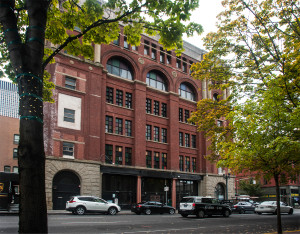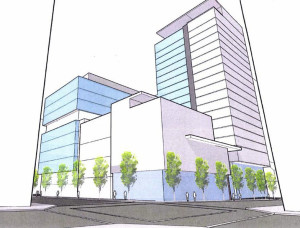
for demolition (photo: Drew Nasto)
The City of Portland has removed historic resource status from two prominent downtown buildings, a decision that is expected to pave the way for demolition and construction of a new hotel on the site. The buildings—the Ancient Order of United Workmen Temple and Hotel Albion—were placed on the Historic Resource Inventory in 1985 and had been subject to demolition protections ever since.
On November 5, the Bureau of Development Services lifted the buildings’ Historic Resource status—a decision that nullifies all historic preservation protections for the properties. Preliminary plans for the site showed that one building would be demolished and the other irreparably altered to make way for the new hotel. Plans anticipate full demolition of both buildings for a hotel and office.
Built in 1892, the Ancient Order of United Workmen Temple is one of Portland’s most prominent remaining buildings from the 1890s. Designed by architect Justus Krumbein, the vacant six-story Richardsonian Romanesque block retains much of its exterior integrity. Revised plans received by the Bureau of Development Services on November 4 show full demolition is planned the Temple.

The 1906 Hotel Albion is best known for the venerable Lotus Café, a legacy business that has occupied the ground floor since 1924. Both buildings have enough historic and architectural significance to be considered for Historic Landmark status—a designation that, under Oregon law, would require the consent of the owner.
The city removed the buildings from the Historic Resource Inventory on the same day that the requests were made by the property owner. Due to a zoning code loophole invoked by the applicant, the Bureau of Development Services was left with little option but to approve the request.
Central to the city’s decision to take the properties off the Inventory is an obscure subsection of the zoning code that honors owner requests to remove historic resource status. The subsection was inadvertently adopted as a part of a larger package of code revisions in 2002 and has resulted in 11 same-day Historic Resource Inventory removals this year alone.

Since distributing a memo to Portland city leaders in July, Restore Oregon has petitioned for the loophole to be closed as part of our broader campaign to protect local historic resources. It is Restore Oregon’s position that the loophole contradicts not only the city’s demolition review provisions, but also the State’s explicit 120-day delay requirement for applications to demolish historic resources.
Had any of Restore Oregon’s proposed policy changes been adopted, the Temple and Hotel would have been subject to a lengthy delay process to allow time for alternatives to demolition to be considered.
Restore Oregon intends to appeal the decision to the Land Use Board of Appeals.


Thanks for your work.
This is so sad.
This is one of the reasons my wife & I left Portland.Is there a petition. Will gladly sign.This is all kinds of wrong!
How silly. The man owns the buildings. You dont want them torn down why? Aesthetics? The new buildings will be functional amd aesthetically pleasing. In America people should be allowed to do whatever they please with their provate property.
That is such crap. So under that theory it would be perfectly acceptable to tear down the statue of liberty or the empire state building just because it fulfills a developers greed quota for the month? Historic properties are still standing for a reason and these two gems are still perfectly functional.
Ya agree with you Eric, lets demolish the White House while we are at it. Hell why don’t we just paint it pink see what kind of stir we get out of that.
The “property rights are sacred” argument is full of holes. Nowhere in the urban United States can people do “whatever they please” with their property. We accept a great many restrictions on what people can do with their property in the interest of the community good. In big, densely packed urban areas, what people do with their properties has an impact on everyone around them, and the community has a right to limit and direct those impacts in positive ways. This concept is not some creeping intrusion of “socialism” into our proud libertarian Americanism, but a well accepted concept that has been part of American civil life for hundreds of years.
That is why we have zoning, health and safety regulations, building codes, and countless other prescriptions for how people can use and build on their property. Saving historically important buildings that the community (through a well documented process) has designated, is just another one of those restrictions that are well accepted throughout the US. It is important to recognize that Oregon is the only state in the Union with an owner consent provision relative to historic designation.
Why do people want to visit Rome, Paris, or places in other cities? Largely to see historic buildings and learn about human history and culture. No number of new “functional” and questionably aesthetically pleasing buildings can replace the stories and experience of human civilization embodied in our architecture.
Even if its wrong
He bought a historic building. That’s a fact. In America, our connection to history is tenuous at best, and Portland has tried to maintain our connection by maintaining our historical aesthetic. If you want to live in a place where everyone just builds whatever the hell they want, move to Alaska. I’ve lived here for thirty years and I intend to preserve some of the old architecture that made me want to stay here in the first place– because I am part of this city and the mighty dollar doesn’t rule all– a city is a joint effort. That’s why we have sidewalks. That’s why we made 1% for art . Don’t like it? Don’t buy an historic landmark building.
How can we all help you fight this? Very sad and disheartening. If this keeps going on…in a few years our city will be unrecognizable.
This is not disimilar to the ineffective tax for demolition on non-historic buildings. Both the loophole and the tax are nods by the City to condone development without any meaningful system for accountability. In other words, it’s a free-for-all for anyone with a wrecking ball…
Thanks, Spencer, for keeping us informed. There are too many valuable buildings being lost in Portland. And where an historic building manages to escape the wrecking ball, the city building codes permit new construction to be built within a few feet of an historic structure, blocking light, air, and privacy (witness The Old Church and John Palmer House, to name two).
My love and passion for my work is preserving beautiful historic houses here is Portland. It breaks my heart to see so many fine craftsman homes being bulldozed and replaced with these disposable houses that are being mass produced by thoughtless developers with deep pockets. Let’s put an end to this slotter of the memory and legacy of our historic builders of the past.
When I left Portland, it was with the intent of coming back. I love Portland, loved its sense of itself, the dynamic and thriving culture, the sense of place. Yeah, things change, that’s to be expected. But about ten or fifteen years ago, Portland seemed to have lost a sense of itself. The last few visits, I haven’t felt at home. It just doesn’t feel like Portland anymore. This makes me sad, because there is still enough there of the Portland I knew and of its energizing culture that I recognize the Lady still. This kind of giving away of a long heritage is a large part of what is happening. Is Portland going to end up just another generic American-style city, instead of the one city in the USA with a human feel and scale?
Pathetic
So very sad to read; one wonders about the “place identity” of decision makers. That section of the city is already difficult to recognize given the one I moved to in 1976 as a teenager. This was when OMC was located across from city hall in a 2 story wooden bldg. I a sad for the town and not proud of theses latest choices.
It’s really sad and disheartening to see historic buildings replaced with anonymous glass boxes what will look dated and ugly 2 weeks after they’re built. I still look at that thing that replaced the Rose Friend apartments and cringe.
The building that replaced the Rose Friend apartments is the Ladd Apartment tower, and I’d agree that it’s pretty banal overall. But there is a story behind that. Originally the developer and architects wanted to embellish the first three floors (the “podium” if you will) that are built out to the street with a frieze and other detailing that would echo design elements of the Ladd Carriage House next door. They also had some echos of classical detailing along the Park Blocks to pick up the visual rhythm of the First Christian Church. While still “modern”, there was a nice homage paid to the historic buildings on the block.
All of that was shut down by the Portland Design Commission (in a hearing that I attended) that demanded “pure” modernist design totally devoid of the horrors of “ornamentation”. As a result, all that “homage” to history was stripped from the design and the result was the dismal box you see today. The only elegant element the architects were able to retain was the sumptuous marble cladding, which when viewed close up, is really beautiful, but which fades into a boring anonymous non-color when viewed from a distance. Alas, this is a case of Portland shooting itself in the foot.
It seems to me that the applicant needs to go through the same process – a hearing and notice- to remove something from the inventory. There was a public process to get it listed on the inventory- then the reverse should be true. Standards must not be different. Where is the transparency and public process?
Historic buildings are a big part of making Portland so special. It’s unfair to the people of Oregon to tear them down and lose the charm/personality of the city. The old, unique buildings are a tourist attraction and it’s awful that developers with no taste are ruining it for their own greed. Why not restore and make a statement like famous architects rather than throwing up another plain Jane building that gets you no recognition. Seems like leaving a legacy would be more fulfilling than one’s own greed.
A decision that will permanently mar the look and feel of one of Portland’s heavily travelled downtown streets should not be made by the Bureau of Development Services, for God’s sake. They make money selling demolition and building permits. It’s a conflict of interest. A historic property is historic. Period. This whole debacle reminds me of a recent trip to Montepulciano, Italy. The charming medieval town has laws about touching the exterior of buildings. If you want to remodel your bathroom, fine. But the huge tourist industry
(largely fueled by good-architecture-starved Americans) would evaporate if the sense of place/history were disturbed. Has anyone at BDS ever travelled?